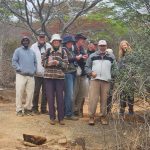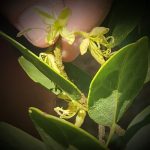TREE LIFE 532
DECEMBER 2024
PLANNED EVENTS:- DECEMBER
Since inclement weather or other issues may vary our plans, WhatsApp Tony Alegria on 0772 438 697 to join our WhatsApp group for last minute updates.
Saturday 7TH December 2024:- visit to the National Botanic Gardens. Meet at 8.30 in the main car park and join us for an interesting morning looking at trees that catch our interest.
Main meeting December 2024:- As usual in December, we leave members to explore and enjoy their surroundings on their own. Our WhatsApp group has been used to identify trees that are “Mis-trees” to you and we expect the number of posts to increase exponentially with the holiday season and the rains. The committee and your editor wish you all a joyous festive season and good botany in the new year.
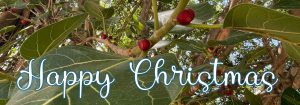
Red sessile fruits of Ficus benghalensis are the Zimbabwe holly berries this year
REPORTS FROM PREVIOUS OUTINGS
Saturday 2nd November 2024:- National Botanic Garden Outing
By Jan Van Bel, photos – Flora of Zimbabwe
In the last 2 days we had some showers which could mean the beginning of the rainy season. Today no rain was expected, the sun was shining and with the dust washed away, the green looked so true in all its hue.
Eight of us had gathered in the parking and with Ann Sinclair and Jan Van Bel leading we took the path past the Xerroderis stuhlmannii, wingpod, which welcomed us with its sprays of panicles of tiny yellow flowers.
The Commiphora ugogensis, river Commiphora, that fell down a few months ago, was still lying in the same spot and raised some questions again. It probably died of age as we’ve seen so many dead trees in the last years .
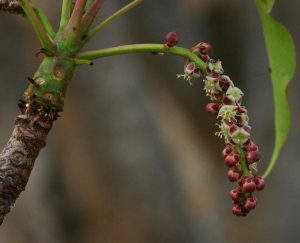
Sclerocarya birrea
We then came to the Marula, Sclerocarya birrea, also in flower. What we saw were probably the male flowers as there were no female parts and we didn’t remember ever having seen fruits on this specific tree. It is a dioecious tree with male and female flowers on different trees.
Also the Baobab tree arrested us to show off its abundance of fruits that had developed fast. Another tree with an overload of fruits, rarely seen so productive was Tamarindus indica. They proved however not yet ripe enough for consumption.
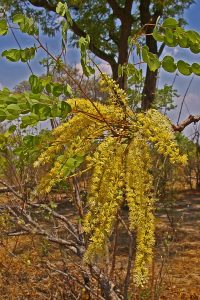
Amblygonocarpus andongensis
The next tree we found in flower was Amblygonocarpus andongensis, the Scotsman’s rattle. Yellow spikes of flowers seen here and there between the new fresh green compound leaves. Some of the typical square pods were lying around and did rattle.
The Commiphoras were coming into leaf and we tried to remember the names of the 3 different species: viminea, zebra-bark; caerulea, blue-bark; I don’t remember the 3rd one.
By now some of us had already turned around, back to the parking. A quick detour to the Hovenia dulcis, Japanese raisin revealed the small insignificant flowers that were going to grow in an abstract rooster of raisins, of which the fruit stalks are eaten, not the raisins. We strolled back to the cars, enjoying the relaxed quiet Saturday morning.
Sunday 17th November 2024:- A visit Patrick Mavros’ Mpata Farm
By Mark Hyde, Photos by Mark Hyde and Bart Wursten
It was a dull grey cloudy humid start to the day with a chance of rain which we decided to ignore and indeed the rain held off and there were even a few patches of blue sky.
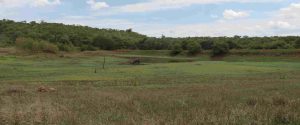
Perhaps because of the weather or clashes with other events, we had only a small group of members, namely Ann Sinclair, Stuart Wood, Dawn Siemers, Jan van Bel, Tony Alegria and me.
To get to the Farm we went to the Mavros homestead along Haslemere Lane, turned sharp left and descended steeply into a lower area of rocky woodland. The vegetation type was essentially miombo woodland (msasa and mnondo) with some rock-loving species thrown in and some trees typical of the slightly lower altitude (Brachystegia boehmii, Mfuti). The altitude was just below 1400 m so a little lower than most of Harare.
Having parked the cars we set off recording trees. One subject discussed was the question of trees with unisexual flowers. These can either have sexes on the same tree but in different locations and sometimes appearing at different times of the year (monoecious) OR on separate trees (dioecious).
The first one encountered was the pioneer species, Dodonaea viscosa, the Sand olive, which often occurs in scrub. Our first tree was female, the styles which were long-extended from the flowers were very noticeable and there appeared to be no male parts. Nearby, however, was a tree which appeared to have both styles and stamens. Had we found both monoecious and dioecious trees? However, trees do not always follow the rules. Some years ago, we looked at the Uapaca kirkiana trees near the Interpretive Centre at Domboshawa. While most were clearly either entirely male or entirely female we came across one with one side mostly male and the other bearing female flowers.
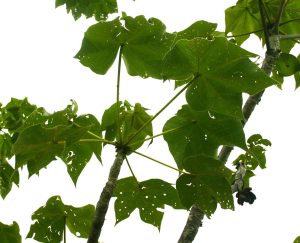
Sterculia quinqueloba
Nearby was a flowering Pseudolachnostylis maprouneifolia, the Duiker-berry. This is in the family Phyllanthaceae, carved out of the Euphorbiaceae, and the species in both of these families have unisexual flowers. This was a tree with female flowers.
Perhaps the most interesting species in the woodland was Sterculia quinqueloba, the Large-leaved star chestnut. We more often see this at lower altitudes than in Harare, but it does occur in the hills to the north of the city. At one point on the walk, we were close to no fewer than nine specimens of this tree.
The flowers of sterculias are unusual in that they lack petals; the coloured part is in fact the calyx. They are also unisexual. However on this occasion we did not see any flowering trees.
It was odd how many alien species were well-established in the woodland, in particular:
Jacaranda
White poinsettia – Euphorbia leucocephala
Lantana camara – in great quantity
Species of Ash – Fraxinus
Glossy privet – Ligustrum lucidum
Syringa berry – Melia azedarach
Guava – Psidium guajava – many of them!
A certain amount of debate took place over the termnalias. Eventually, we concluded that both Terminalia stenostachya and Terminalia mollis were present.
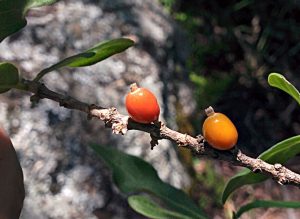
Tricalysia niamniamensis with ripe red fruit
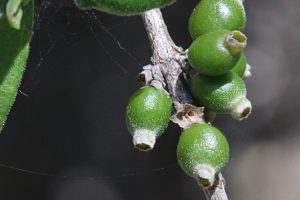
Tricalysia niamniamensis fruit with white calyx
Finally, I would like to mention Tricalysia niamniamensis. This shrub belongs to the Rubiaceae, the Coffee family. It’s very widespread in Zimbabwe, but not very distinctive and hence not very well-known but it does occur quite often around Harare. The fruits bear the white remains of the calyx and turn red when ripe.
Incidentally Dr Georg August Schweinfurth, who gave his name to so many of our plants, was a German botanical collector and taxonomist and here the unusual specific name niamniamensis comes from a collection he made in 1870 in the ‘Lande der Niamniam’. Niam Niam extended roughly from Lake Chad to the White Nile in what is now South Sudan and in DRC to the equator. He wrote “Whoever knows the blameless avarice of a plant-hunter will understand how these studies could only arouse in me a craving after fresh booty”
In summary, it was a very pleasant way to spend a Sunday morning, and I made quite a long list of species.
More notes from our Matabeleland Expedition
beyond the Matopos ….
Onward and down to Rocky Glen – 5 October 2024
By Ann Sinclair
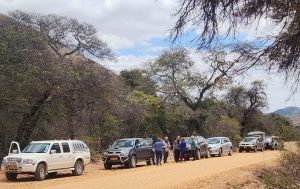
Our convoy
The day dawned with some bright sunshine but it was still cloudy and cold. Our convoy of cars led by Cathy Sharp left Camp Dwala at 9.30. We had an excellent breakfast and then collected lunch rolls from the kitchen before heading through tribal lands towards Gwanda.
Our first stop was in a grove of Msasa to admire their spring colours. Always a breathtaking site.
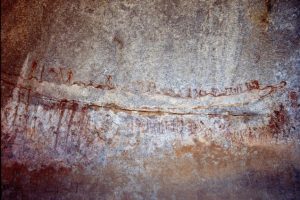
Galubahwe Cave Painting
Then on to Gulubahwe Cave, a world heritage site.
Here we parked by the side of the road and although Tony thought it would be too steep for me, kind Judy Ross guided me up the rocky slope up to the cave (more a shallow overhung rock). There are a few layers of paintings done at different times but the main feature is a long hump-backed animal, possibly a snake, with people dancing on its back.
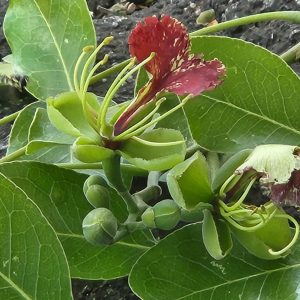
Afzelia quanzensis – Pod Mahogany tree
A little further on we stopped for lunch under a magnificent Afzelia quanzensis, Pod Mahogany tree. This provided plenty of shade as we perched on the rocks surrounded by goats before we re-embarked back into the cars to the main Bulawayo/ Beit Bridge road.
This was full tar and good, so gratefully we sped along past Colleen Bawn, the large gold mine, only to be stopped when Tony got a message to say Karl had a problem – so we turned back to help him with a puncture. Setting off again we had not got much further before there was another call from Karl, he had a second puncture! Fortunately, his vehicle was equipped with two spare wheels and we were soon on our way again.
Finally, we came to the turning to Rocky Glen. It took a while to gather all the cars for the security to check, but then we were in and wending our way to the ranch through lovely wooded rocky terrain.
Di Drummond was there to greet us and direct us to our accommodation. She very generously put all 19 of us up for 4 days. Some camped and others were in very comfortable rooms. We finished the day with another banquet from Francis.
An introduction to Rocky Glen: – 6 October 2024
By Tony Alegria, photos by Mark Hyde
The first tree walk at Rocky Glen saw us moving along the side of the dam to the spill way. As usual Mark looked at everything en route and identified most of the trees. We had an issue of – was it Euclea divinorum or Euclea schimperi? These bushes were everywhere and strangely enough, no animal eats them. We encountered many, many of these bushes and didn’t find a single one that had been chomped on!
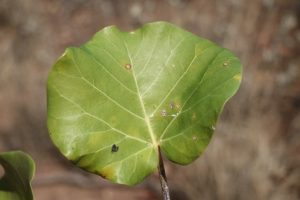
Ficus abutifolia
At the spillway, there were three large trees:
Ficus ingens – with new orangey-green leaves,
Afzelia quanzensis – (pod mahogany) with bright green leaves, and
Ficus abutilifolia – (the large-leaved rock fig) with heart-shaped leaves.
Whilst the Camp Dwala surrounds had many Ficus glumosa (the hairy rock fig), the most common fig tree at Rocky Glen was the large-leaved rock fig. They could be seen from far away wedged between rocks in the hills!
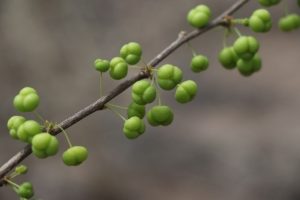
Phyllanthus pinnatus
Nearby was a look-alike of a small tree we had been struggling to identify at the National Botanic Garden which Karl identified as Phyllanthus pinnatus. It has three-lobed fruit resembling a Margaritaria discoidea. Also in the area were Cassia abbreviata (long-tail cassia) and Entandrophragma caudatum (wooden-banana) which were fairly common.
We proceeded to the river below the dam wall and saw some water lilies with spikes on the leaf edges. Also, some water plants resembling four-leaved clover or sorrel (a species of Marsilea). There were a few rather big Acacia galpinii as well as a few trees we couldn’t identify.
After lunch at about 4:00pm some of us went botanising. We went past a graveyard of rusty metal things on a dwala and proceeded along its side. Again, loads of possible Euclea divinorum and many leafless trees with the odd stick with prickles to catch the legs! Saw some big pod mahoganies and “mountain acacia” and many Commiphoras which were common – in one view I saw 6 of them consisting of two species. Although the most common was Commiphora marlothii (paperbark or corkwood), Commiphora mollis (the velvet-leaved corkwood) was also there in numbers. We returned for drinks and snacks just before it was dark.
ENCEPHALARTOS CONCINNUS OR CYCAD DAY: – 7 October 2024
By Di Drumond
All the troops, with Homerai & Arnod, were up early for departure to Nyedzi mountain to explore the cycads. The convoy took a scenic route to the destination, taking in the beautiful vistas of Brachystegia glaucescens in their vibrant variations of spring colours, interspersed with assortments of rock-clinging figs, their serpentine roots visible on the open rocks.
In 1966, this colony of cycads was stumbled upon by a neighbouring rancher, R.H. Rochat, and in 1967 a Mr Smit visited the colony, collecting samples for classification by Dr Dyer & Verdoorn of the Botanical Research Institute, Pretoria. Until 1969, all cycads in Rhodesia were classified as Encephalartos manikensis, however Dyer & Verdoorn split them into E. manikensis, E. chimanimaniensis and E. munchii (all eastern districts) together with E. concinnus.
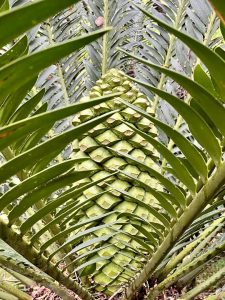
Encephalartos concinnus
It seems that the variations come about from the cones, and the varying form, length, width, colour & teeth setting of the leaflets. There were some E. concinnus in the upper catchment of the Runde River, but it’s uncertain if any plants remain. Another colony is in the Mbwerengwa communal land, near the confluence of the Biri and Nuanetsi rivers – this was surveyed in 1991 when 34 plants were recorded.
The derivation of the name is of interest the genus being derived from Greek while the species name comes from Latin. The Greek part is
en (within),
kephali (head), and
artos (bread).
According to Smit the Latin, concinnus refers to the neat appearance of the plants, while other references state the tidy arrangement of the male cone-scales. The word “cycad” comes from the Greek word koïx, a type of palm tree and was first used in 1845. Cycad.
The stem – on the outside old, dry & persistent leaf bases which compress with age. Within is a corky cambium around the central pith. Early settlers to South Africa noticed this pith was consumed by the locals, so they named the cycad the “bread tree”.
Cycads are Gymnosperms, they made up about 20% of the world’s flora during the Jurassic period about 250 million years ago. How this species, and these particular specimens, have survived and how & where they are, only they know!
A 1991 survey indicated 48 mature plants in the colony, reproducing primarily by basal suckering. Specific to this species, older stems will produce buds or branches along the length of the stem. A mature plant may have up to 8 stems. Another single plant has been found in the granite hills along the Bubiana River.
A fire swept across Nyedzi mountain in September 2022, burning its way through the plants. Fire has been a regular part of the cycad’s natural history, with the plants making a full recovery. However, a few elephants managed to damage some of the ancient procumbent stems, but even this did not kill the plants. “Collectors” have caused the most damage to the Southern African cycad populations, some of them becoming extinct in the wild, and all on the IUCN Red List of critically endangered plants.
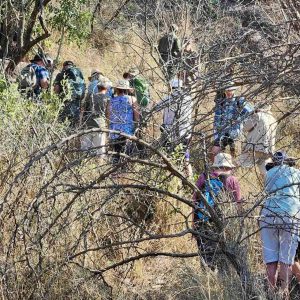
All members of the group were able to move up to the lower plants, while others meandered further up the ridge to the main bulk of the colony. Some old male cones were visible, but there was no sign of female cones or dispersed seed. This is perfectly normal. After lots of observations & conversations, we moved back down to the low ground, where Mark, Jan & Karl were delighted to find a grove of Homalium dentatum, something new for many of us! The group found a bit of mottled shade, and perched themselves upon various shaped rocks to enjoy another “takeaway” from Francis’s mobile kitchen!
Some of the group returned to the homestead, while others went further on to investigate Cathy & Di’s “tall, dark, handsome fellow” aka Meg’s hybrid! The group concurred with Meg’s opinion that this was a B glaucescens hybrid, but the jury is still out on which species it has hybridised with! We wandered around this area for a while, an abundance of Gardenia resiniflua and G. volkensii, but only one G. volkensii in flower.
On the drive back, we stopped at a spectacular specimen of Ficus tettensis, which was of great interest. This was another Meg ID!
In the afternoon, Jan convinced me that there are in fact two species of planted “Natal mahogany” in the yard, dispelling my belief that they were all Trichilia emetica, when in fact the one was T. dregeana (the forest Natal mahogany)!
Another great botanising day, with relatively mild heat, opportunity for some bird watching & downtime in the afternoon. In the evening, Peter set up his magnificent telescope, and he & Tony, armed with his laser pointer, treated us to a sighting of Saturn, a double star, and some other night sky delights in the dark sky! An unanticipated addition to this interesting & stimulating outing!
THE BUBIANA GORGE AND ROCK PAINTINGS: – 8 OCTOBER 2024
By Jan Van Bel
Our host Di proposed a visit the Bubiana River gorge but to evade the heat we experienced the previous day, we would start at 6.30h. So as not to delay our departure, our Captain Frances prepared a packed brunch the evening before. In the morning it was again freezing cold and everyone was wearing winter clothes. We consumed tea or coffee and by 6.30 everyone was ready for our departure. The expectations and the desire to go there must have helped in keeping to the planned time, but would not have been possible without the strong hand of our Captain.
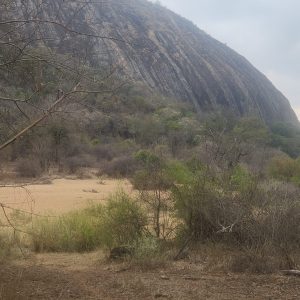
Bubiana gorge
With 6 cars in convoy we drove about 20 minutes over good bush roads to arrive at the gorge of the Bubiana river. We parked on the bank in the shade of a Jackal berry, Diospyros mespiliformis and a Brachystegia tamarindoides, mountain acacia.
The dry riverbed lay 4m deep from the bank. The opposite side of the 40m wide riverbed looked very green. Walking over the river sand we were watched by an African hawk eagle. From far we already could identify the combretum microphyllums by their spikes of pods. Mimusops zeyheri, species of Euclea and Mundulea were plenty. By now the sun had come out and jerseys and jackets had to come off.
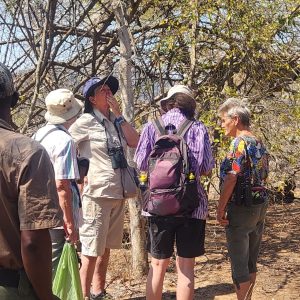
Most tree species we already recorded yesterday. We were still deciding on the many eucleas if they were schimperi or natalensis species.
Then we encountered something we hadn’t recorded: Homalium dentatum, Common homalium, a brother of Homalium abdessammadii we are so familiar with and which we see every time we park at the National Botanical Gardens. A few of these trees were standing in a small area. They all had large straight stems with a spreading crown high up.
Also, a welcome encounter was with the several aged Stem fruits, Englerophytum magalismontanum trees with their dark green leaves, quite distinctive. More excitement when we met a Nuxia oppositifolia, River nuxia. With its narrow leaves. we started seeing more of them.
Walking higher up the bank the trees were bigger and older. Another taller big tree proved to be a Nuxia congesta, Brittlewood. Their leaves in whorls of 3 and flowers reminiscent of sambucus, elderberry tree. Maytenus undata, Koko tree, which likes rocky areas was also present and always nice to encounter. Certainly someone must have done the folding-leaf test to see the grey line.
Then the beautifully sculpted boulders in the riverbed attracted us and drove some of us out of the bush. Soon we were jumping from boulder to boulder along the riverbed, avoiding the big round rock cauldrons which must have been crafted by a mighty power of a roaring churning river and some of which still held water. Near one small pool Carl found footprints of a pangolin, which was more interesting than the bushpig droppings he discovered and collected a little further.
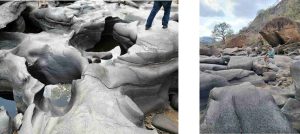
Terminalia gazensis, fringe-leaved terminalia, with the soft hair on the leaf margins, a tree which I rarely see, was pointed out by Carl. Vitex regularly seen, remained undecided as to which species it was. Waiting for Mark’s report. Heteropyxis dehniae, lavender tree, gave us a temporarily olfactory pleasure. Quite a big specimen that had an Ansellia orchid growing on it. Another orchid was seen on a mopane tree.
The search for the Ficus tettensis, small-leaved rock fig, seemed to be over when Di stopped us at a big rock with 2 fig trees on it. The Ficus tettensis is a small tree growing on rocks and the leaves are kidney-shaped and not big as with the other species. One of her scouts went up to get a young leaf and it could well be the Figtree we’ve been expecting to see since we arrived here. However doubt remains if it’s not the sycomore or the abutilifolia which we see here regularly. Mark will tell. [Editor’s note: Mark confirms that the tree was Ficus tettensis].
Another new species for most of us was a shrub full of small spherical dry fruits and otherwise leafless. Mark introduced us to this Tinnea zambesiaca, for which Di, who had been wondering for some time what this might be, was very happy to enter it in her notebook.
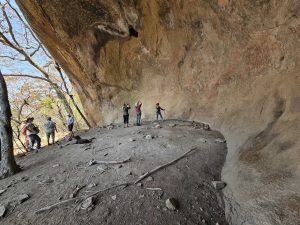 Back on the road and after a 15 min drive we arrived at the place where we had to climb up a mountain to go and see a cave with rock paintings. It was one of the bigger types with an elaborate painting of people and animals. One vague picture seemed to depict a giraffe. Opposite the cave and hiding it was a huge perfectly shaped round rock. Most of us brave people succeeded in climbing it to the top without slipping off. The breathtaking view up there with a 360° panorama needed no words and everything became very quiet for some time.
Back on the road and after a 15 min drive we arrived at the place where we had to climb up a mountain to go and see a cave with rock paintings. It was one of the bigger types with an elaborate painting of people and animals. One vague picture seemed to depict a giraffe. Opposite the cave and hiding it was a huge perfectly shaped round rock. Most of us brave people succeeded in climbing it to the top without slipping off. The breathtaking view up there with a 360° panorama needed no words and everything became very quiet for some time.
On the way back we passed through the very extended farm with plenty of horses and endless fields of crops before having a small stop at a most romantic homestead next to another huge lake, which was the home of one or more of Di’s children.
Again this has been a long day full of variety. The day was not yet over. Back at our lodge, we still had time for a rest. Then there was a delicious dinner (could have been a braai by our famous barbeque specialist Tony). I had stopped taking notes. We probably even had a Quiz by Bill and maybe a star gazing session with a very big portable telescope by Peter, who also showed us a most clear picture of Saturn.
A BUSHVELD RAMBLE: – 9 October 2024
Text by Karl Van Laeren. Pictures by Mark Hyde.
Di drove us out for another familiarization tour. By now I was settling in quite nicely and becoming more familiar with some of the majestic scenery. I had been forewarned that Rocky Glen was one of the finest scenery places in the SE lowveld.
We passed Gurumanzi Pan which is being pumped and stopped to admire a really large Manilkara mochisia tree (Lowveld Milkberry due to its latex especially in younger specimens) next to the road. This is always quite a rare but remarkable tree. It’s one of my keystone species as one remembers every single specimen one ever sees as they seem to be so scarce and always leave a lasting impression. The gardens at the Rocky Glen HQ also has a fine specimen with its dwarfed lateral branchlets with leaves clustered in rosettes at the end of these short twigs somewhat like the arrangement in a Zig zag Terminalia stuhlmannii. Like its cousin, Mimusops zeyheri (much more common, Red milkwood), its fruits are sweet tasting and sought after by everyone. A feature of the fruit is its large recurved calyx lobes as seen in Mimusops too.
A walk with figs, creepers, granite and elephant poo to boot has to be uplifting and constantly drawing one onwards and upwards. Alas, tree society walks often move at such a slow pace that even lichen appears to progress faster! So, I hatched a plan to use Annelie as my scribe while I went out exploring so I am “winging” this next bit based on her notes.
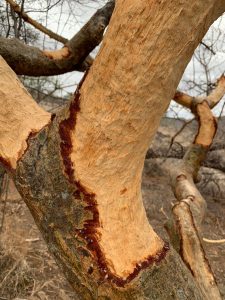
Commiphora mollis
bark eaten by dassies
It was interesting to see the paths created by Hyrax species as one gets both the Rock and the Yellow spotted hyrax here. We added the bark of Dalbergia nitidula and Ficus abutilifolia (large leaved rock fig) to the growing list of de-barked plants consumed by hyrax in time of need (they live independent of water and basking out on hot rock faces must come with a high rate of water transpiration!) This list already contains Commiphora marlothii, Commiphora mollis and Diospyros lycioides.
Civetries, civet middens, can be a rich deposit of hard-to-identify seeds often in dung that is exceptionally thick – up to 39 mm in diameter – and thus larger than that of leopard even (extremely large for such a small omnivore) indicated just how abundant these nocturnal animals are. Di taught us something on the texture of their dung as it often disintegrates into powder on the slightest pressure. Millipede rings may also be seen in their scats.
Oops, we digress from Botany, so I continue:
Boscia trees have always challenged me, and I was pleased to see that I was not alone as Mark was too. But rather than give up Mark visited the herbarium after this trip and his findings should remove this identifying conundrum for ever more. We were seeing Boscia angustifolia which means “narrow leaved” but this is misleading as often the leaves were anything but narrow and Boscia albitrunca means “white stem’ but then Boscia angustifolia also shares this feature! Stress no more. The under-leaf venation tells it all – Boscia angustifolia has prominent underside venation whereas in Boscia albitrunca the veins are scarcely visible
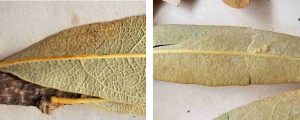
Boscia angustifolia Boscia albitrunca
with prominent underside venation with scarcely visible underside veins
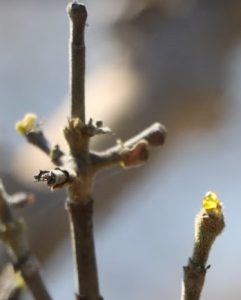
Gardenia resiniflua
Gardenia resiniflua (Resin Gardenia) was common but just coming into leaf and into scant flower. What is nicer than seeing a blob of yellow resin on a terminal bud projecting a concentrated beam of golden sunlight in harsh dry bushveld. But you need to search for the resin as it’s not a feature of the majority of buds.
Tinnea rhodesiana (which grows in six Southern African countries) gives itself away even when leafless by its persistent light brown” Donald Duck” like calyx. In the rainy season beautiful burgundy petals project out of the globose duck’s bill calyx lobes contrasted by bright yellow anthers.
Mundulea sericea or cork bush is another very widely spread plant that will impress when in lavender flower. Its bark contains rotenone and if added to a small pool of water will kill the fish therein. Cooking the fish denatures (breaks down) the poison.
Hexalobus monopetalus is a rocky kopje loving species and is normally identified by the buds that form in autumn and sit out the winter unopened till early spring to burst forth in long scraggy off-white petals before any leaves appear. By February the tree may be covered in large irregular shaped tasty fruit that will stain your hands red when collected. Beware as often the fruit is parasitized (adding protein)! When in leaf the leaves tend to arrange themselves in a flat plain and the midrib below can be covered in red hairs (Burrows et al. Trees and Shrubs of Mozambique)
Hard smooth wooden galls in groups were seen on Artabotrys brachypetalus and the large woody spines of trailing stems was another giveaway. Spiny hedgehog-like galls are not uncommon on Dalbergia nitidula making identification by association possible when plants and dry and leafless.
Vepris reflexa (Woodland ironwood) is another rocky outcrop species which was found although as a trifoliate species can easily be confused with Searsia (Rhus) species and Allophylus. Consulting Meg’s key points on this species she indicates that the leaves on Vepris tend to be very flat whereas in Searsia it may be curled “looking as though it is too tight”. Also, the leaflet stalks on Vepris are short but distinct compared to being absent on Searsia. Since Vepris is from the Rutaceae or citrus family the leaf also has a more aromatic smell when crushed due to pellucid glands which can be seen when held up to the light. The wood is light in colour and can reach a density of nearly equal to that of Brazillian teak (1,060kg per cubic meter per Stephanie Dyer et al: Southern African wood)
Our editor, Linda, is hounding me and as can’t remember any more details so I am now approaching the end of my write-up, but what I will never ever forget is the moving experience of seeing those bright green age old Rundi cycads, a day or two earlier. Reflecting on botany trips in general, both seeing fields of living fossil plants like that of Welwitschia mirabilis in the Namib desert and a hillside of endemic cycads in the SE Lowveld of Zimbabwe will be cherished experiences for life. Thanks to the land owners and everyone who made this trip a reality.
Editor’s note: Before returning to the homestead for a final evening (see the article from Frances, “Not all about the trees”) we drove to the family sundowner patch on the top of a gomo. Some of the party ventured further up the hills to enjoy the 360o view while the rest of us enjoyed the views to the west where the sunset on Tony compiling the bird list for the occasion.
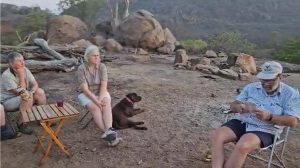
FAREWELL TO MATABELELAND: – 10 OCTOBER 2024
By Fiona Lawrence
As with all outings and trips, all good things must come to an end!
The final day arrived and it was time to leave. Packed breakfasts and lunches had been prepared the previous day. Early risers leaving at dawn were headed to Harare for the long trek home while those only travelling to Bulawayo, Masvingo and Jabulani safaris enjoyed a leisurely breakfast before departing. All cars arrived safely home (although we understand that Karl and Annalise had a third puncture!)
As we said goodbye to Di Drummond we gave heartfelt thanks to her for hosting us at her beautiful property and giving us a taste of a countryside we had not previously seen.
Perhaps we will be back there in the future to see more.
A very interesting and memorable trip to Matabeleland.
AND NOW FOR SOMETHING A BIT DIFFERENT:
NOT ALL ABOUT THE TREES!
By Frances Morris Photos by Frances Morris
Any longstanding Tree Soc member knows that not all of us can be completely absorbed in the finer differences of why the name that completely eludes us fits the specimen dangling before us, and that we seek other forms of brain stimulation after dinner (to counter the effects of our cooler boxes).
Our last night at Camp Dwala was very special, a freezing evening all gathered in the splendid dining/lounge area, with extra visitors from Bulawayo and Gavin Stephens and his mother. Gavin gave a wonderfully insightful talk on the history of Camp Dwala and his family involvement, a remarkable story of preservation and conservation and co-operation.
Thankfully Bill and Fiona once again volunteered to draw up quizzes, carefully divide us into teams and then keep us wracking our brains, shaking our heads, and shrieking with mirth at the answers. Some players are still trying to work out the meaning of some of the official answers. Believe me, we tried hard to outwit the Quiz Master but he was a stern taskmaster and his word was final (subject to leniency).
The combination of brains and life experience in each team meant that none of the scores fell less than 80% but one or two team leaders were somewhat smarter than the rest of us. All conniving was in vain though and the scrupulously fair Quiz Master ensured that every player received the same reward, a carefully collected bit of Zimbabwe change, the good old pen! A great deal of hoarding prior to the trip.
Unfortunately, after the second uproarious quiz, a participant met a garden tap in the dark on his way to bed and reappeared in our pool of light pouring blood from his leg. The vets and the doctor, ably assisted by the lamp holder Fiona, had to practice their skills with a needle and thread and repair the damage. Luckily for all, the patient is recovering despite the theatre team’s less-than-ideal working conditions (think wind and cold!)
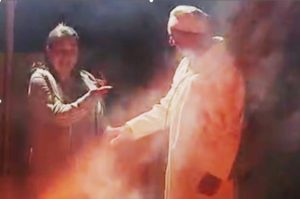
Our final night was splendidly entertained by Bill and Fiona playing Doctor and Patient, so apt, and for a small fee, Linda will share a copy of the skit with Tree Life members. All participants thoroughly enjoyed every evening, lots of shared knowledge, discussions, star gazing, but a very special thanks to Bill for his “glue” that holds it all together with entertainment and care and concern for all.
The editor’s award for the most relevant team name was “Botanical bullshitters”, they won the first quiz night !!
Short notes
MORE ON PLANT NAME CHANGES
By Mark Hyde
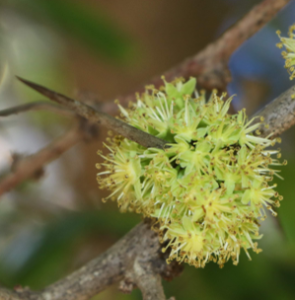
Dovyalis afra
In Tree Life 529 (September 2024), we published an article from the Smithsonian Magazine on the decision made at the International Botanical Congress in Madrid to retroactively change the names of species which involved the word caffra.
Most of the reporting in magazines and the non-technical press and even in the Smithsonian article suggested that ‘caffra’ would become ‘affra’ with two fs. However, this is not correct, ‘caffra’ will become ‘afra’ with one f.
For those interested there are full technical details online at https://onlinelibrary.wiley.com/doi/full/10.1002/tax.12622.
This is the proposal which was originally put forward in 2021 and which was accepted in July 2024. The change is retroactive and there is no change to the original author citation.
As far as Zimbabwean plants are concerned there are three specific names which are affected, caffra, cafra and caffrum. The new names are as follows. I have included all life forms, not only trees. There are some very well-known species whose names are changed.
In the following, BG means the National Botanic Garden in Harare.
| Amended species name | Notes |
| Acacia afra | Tynwald acacia |
| Adenostemma afrum | White water daisy |
| Doellia afra | |
| Dovyalis afra | Kei-apple |
| Erythrina afra | Coast coral-tree. Cultivated in BG |
| Grewia afra | Climbing raisin |
| Habenaria afra | Change of rank for this – it used to be Habenaria falcicornis var. afra |
| Harpephyllum afrum | Wild plum |
| Maerua afra | Bush cherry |
| Microchloa afra | |
| Mimusops afra | Coastal red milkwood. Cultivated in BG |
| Pimpinella afra | |
| Protea afra subsp. gazensis | Manica protea |
| Rauvolfia afra | Quinine tree |
| Sclerocarya birrea subsp. afra | Marula |
| Talinum afrum | Porcupine root |
| Tinospora afra | Orange grape creeper |
| Vincetoxicum afrum | |
| Ximenia afra | Sourplum |
THE RECEDING WATERS OF LAKE CHIVERO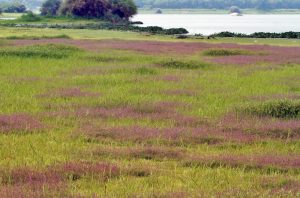
By Ian Riddell, photos by Ian Riddell
The lake shore at Chivero uncovered the most striking colours. Although I didn’t look at the grass in detail, it was probably Couch grass – digitate with mostly 2-3 spikes, giving a purple show.
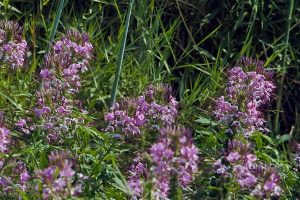
Cleome houtteana
What was noticeable, also in purple, was the Cleome houtteana. This spot would be underwater at normal lake level, but the plants obviously survive and regrow when it drops, as I saw them here in 2019.
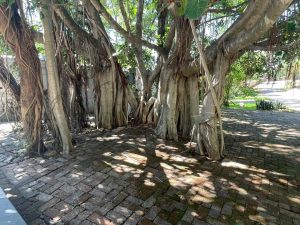
Ficus benghalensis, the Banyan tree
FICUS BENGHALENSIS, THE BANYAN TREE
Firstly my thanks to Karl Van Laeren who has provided us with the beautiful red sessile berries of this tree to use instead of holly berries this Christmas.
The red sessile fruits plus the large quantities of aerial roots suggest Ficus benghalensis, the Banyan. Here is an unusual setting for this exotic tree also provided by Karl.
TREE SOCIETY COMMITTEE AND CONTACTS
Chairman Tony Alegria tonyalegria47@gmail.com 0772 438 697
Vice Chairman Mark Hyde mahyde@gmail.com 0772 233 751
Honorary Treasurer Bill Clarke wrc@mweb.co.zw 0772 252 720
Secretary Teig Howson teig.howson@gmail.com 0772 256 364
Venue Organiser Ann Sinclair jimandannsincs@zol.co.zw 0772 433 125
Committee Member Jan van Bel jan_vanbel@yahoo.com 0772 440 287
Committee Member Ryan Truscott ryan.kerr.truscott@gmail.co 0772 354 144
Committee Member Sibusiso Malunga busimalunga@yahoo.com 0775 889 898
Tree Life Editor Linda Hyde Lmharwin@pentact.co.zw 0772 232 075
Tree Society Website https://treesociety.org.zw/
Tree Society Facebook https://www.facebook.com/groups/ztreesociety/
Flora of Zimbabwe: https://www.zimbabweflora.co.zw/
Flora of Tropical Africa: https://plants.jstor.org/collection/FLOTA


